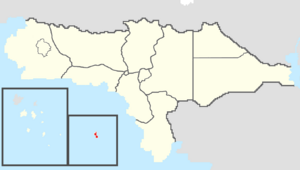St. Ellen
This article is incomplete because it is pending further input from participants, or it is a work-in-progress by one author. Please comment on this article's talk page to share your input, comments and questions. Note: To contribute to this article, you may need to seek help from the author(s) of this page. |
St. Ellen | |
|---|---|
| Motto: | |
 Map of Rizealand with St. Ellen in red | |
| Country | |
| Before annexation | Colony of St. Ellen |
| Capital (and largest city) | Ellensport |
| Formation | December 7, 1773 |
| Government | |
| • Governor | Patrick Kennedy (TNC-NRP) |
| • Legislature | St. Ellen Legislative Assembly |
| • Federal representation | Councilors
|
| Area | |
| • Total | 1,128.96 km2 (435.89 sq mi) |
| Population (2021) | |
| • Total | 58,108 |
| • Density | 51.47/km2 (133.3/sq mi) |
| Time zone | UTC+8 (Vehemens) |
| Abbreviation | EL |
| ISO 3166 code | RZ-EL |
| Website | www |
St. Ellen is a dependent overseas territory of Rizealand located on the island of St. Ellen in the center of the Vehemens Ocean. St. Ellen has a total area of 1,128.96 square kilometers, making it the smallest territory and political division of Rizealand. St. Ellen also has a population of 58,108, making it the least populous territory and political entity in Rizealand. St. Ellen's capital and largest city is Ellensport, and it is the only territory and one of only two political divisions to be non-contiguous with the rest of Rizealand.
Etymology
St. Ellen is named after its predecessor, the Colony of St. Ellen, which was founded by the Caldians in 1601 and named for St. Ellen, the patron Sotirian saint of Caldia.
Geography
Ecology
Climate
Conservation
Demographics
Population
Language
Religion
Health
Education
Urban Areas
Government and politics
The government of St. Ellen is organized according to the Constitution of St. Ellen and is established by the St. Ellen Organic Act of 1976. As a territory of Rizealand, St. Ellen does not exercise the same sovereignty that states or sovereign indigenous nations do. The Rizealand Articles of Federation does however guarantee St. Ellen representation in the federal government and while the Central Assembly has the power to override any act of the government, it must pass as a super law if the territorial government action involves a local issue that does not affect the national security or interstate commerce of Rizealand. The St. Ellen Organic Act of 1976 creates further restrictions on the government of St. Ellen, requiring it to form a democratic government and prohibiting it from making alliances with foreign governments, declaring war, raising or maintaining armies, establishing forms of currency, and placing unlawful restraints on interstate and international trade. Like the federal government of Rizealand, the government of St. Ellen is divided into three branches of government.
The legislative branch consists of a unicameral Legislative Assembly. The Legislative Assembly's 25 seats are filled through closed party list proportional representation elections held every three years. As the legislature, the Legislative Assembly is responsible for enacting legislation and can do so with a simple majority, although a majority of two-thirds is required to override the Governor's veto or remove government officials from office. The Legislative Assembly is also responsible for approving the Governor's executive and judicial nominations.
The executive branch is headed by the Governor who is the head of state and government elected in a two-round direct election at the same time as the Legislative Assembly for three-year terms. The Governor is responsible for signing legislation into law (although the Legislative Assembly can override his veto with a simple majority), nominating executive agency heads and judges, and enforcing the laws of the territory.
The judicial branch consists of the High Court, District Court, and village courts. When a judicial vacancy arises, the St. Ellen Judicial Nominating Commission evaluates candidates and nominates a slate of three to five nominees. From that slate, the Governor then nominates one individual who becomes judge or justice upon being confirmed by the Legislative Assembly and serves a life term with a mandatory retirement age of 75.
There are also independent agencies and commissions established by the St. Ellen Constitution that do not neatly fit into any branch of government, as they often enforce territorial laws (executive), issue rules and regulations (legislative), and adjudicate cases or claims (judicial). While their agency heads or commission members are usually nominated or appointed by the Governor, they can only be removed from office through impeachment and removal by the Legislative Assembly.
Although historically St. Ellen had a civil law legal system from its roots as a Caldish and Gaullican colonial possession, it now operates under the common law legal system as mandated by its organic act.



